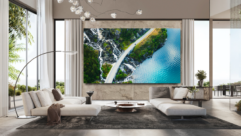LED Pulse uses thousands of strings of LED lights to make volumetric displays that, while not technically holograms, look a lot like them. The latest iteration of their technology is called Dragon O, and it can be as big as a room and display any sort of content its creators can dream up.
The company calls the individual lights “LED neurons,” and compares their function to that of neurons in the human brain; both receive information through electrical impulses, and while capable of functioning independently, can only create an idea (or, in this case, an image) when working cohesively.
The lights can also be called voxels–the 3D version of a pixel; if a pixel is a square or a point on a flat, two-dimensional image on a screen, a voxel is a point on a grid in three-dimensional space. The layered setup of voxels means LED Pulse’s installations are truly three-dimensional; any different angle you view them from, you’ll see something different..
“If you have a volumetric human made out of light, and you walk around the back, you will see their back. If you go to the left, you will see the left arm. It’s all exactly how it would be in the real world,” Pulse’s founder, Danilo Grande told Digital Trends. “Every time we create an exhibition, we invite people to walk around, not to stay in one place only.”
LED Pulse measures its light displays in cuboids (like cubes, except rectangular instead of square-shaped, meaning not all sides are the same length). Each cuboid has a volume of three cubic meters and contains 24,000 voxels. Cuboids can be put together to make larger displays, with the largest thus far consisting of 6 cuboids and a corresponding 144,000 voxels.
In recent years, there have been a number of different approaches to building volumetric displays. Digital Trends has covered many of them. A report from market analysts at ResearchAndMarkets believes the market will be worth $1.7 billion by 2027. But despite these optimistic projections, the technology has yet to be perfected.
What makes LED Pulse’s volumetric display impressive is that, unlike some of the ostensibly 3D projections out there (which are often just variations on the old Pepper’s Ghost illusion that dates back to Victorian times) it is genuinely three-dimensional. Remember the famous Tupac Shakur “hologram” from Coachella? While certainly impressive, it was not really 3D in any meaningful sense. Viewing it from different angles would not give you a different perspective of the performance any more than watching a television from an angle would change the perspective of what you see on screen. -Luke Dormehl, Digital Trends










